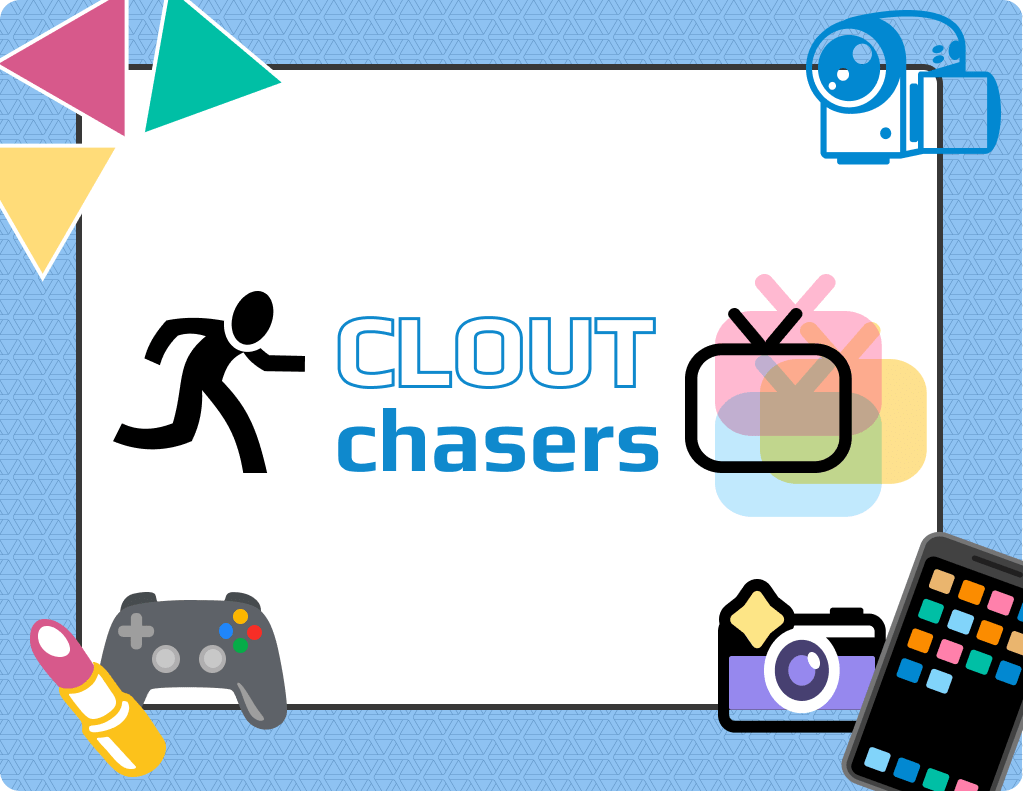Team Members: Miranda, Daniel, Ember, Jasmine, Ivan
Overview
Welcome to the age of the internet! In Clout Chasers, you will play as an up and coming content creator that wants to make it BIG and spread their influence across the internet. Will you be able to create the content that conquers social media and goes viral?
 (Game cover image)
(Game cover image)
Our goal for Clout Chasers was to demonstrate how participating in social media, particularly as a content creator, influences the very Internet landscape one must navigate. How does you gain “clout” and develop a following? What are the tools you’ll need and the decisions you’ll have to make, especially when it comes to interacting with others chasing that same goal of making a name for themselves? We want players to gain a greater understanding of this landscape, what goes into content creation, the effects of Internet-specific interactions, and their personal takeaways answering the aforementioned questions.
To accomplish this, we designed an ecosystem involving a visual representation of the Internet, player pieces to signify the following or “clout” players gain along the way, and an expansive deck of cards representing resources at the players’ disposal. The central visual board is a general social media landscape that spreads into some of the most popular regions of the Internet: Health & Fitness, Beauty, Cooking, Art & Music, Comedy & Pranks, and Gaming. The cards are typified as Item, Action, and Content cards, as different kinds of objects that players will utilize in different ways for their growth strategies. Finally, the Internet is ever-shifting, oftentimes out of your individual control! Each round, the game’s board state changes with the Trending mechanic, offering a bonus to one randomly selected topical region.
Concepts and Models
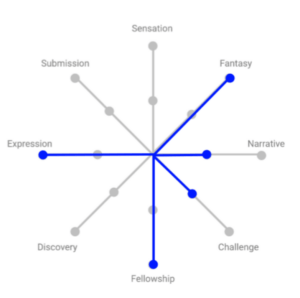
(Goals for types of fun)
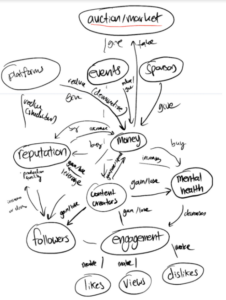
(Initial system map)
In our first exploration of the system and game concept, we had an idea of the high-level kind of game we wanted to make: a fun game geared towards Fellowship, Expression, and Fantasy, alongside some competitive Challenge. Our learning goals would mostly be accomplished in experiencing the ecosystem. This was much more complex to map, and as seen in the above first system map, there were lots of objects, interactions, properties, and generally messy moving parts.
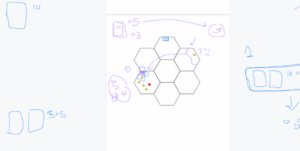
(Game design brainstorming)
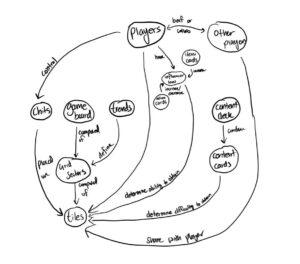 (Final system map)
(Final system map)
As we iterated through our playtests and revisions based on feedback (detailed more below), we eventually we able to narrow down what pieces we felt were important to focus on and what could be simplified, merged, or cut. The above is some of our whiteboard brainstorming for what our game would look like, as well as the final system map.
Initial Decisions
We decided on the game being designed for 3-6 players and targeting a 16+ age range for teens and young adults. Below are some of the other important decisions involving our game’s formal elements and first iteration:
- Win condition: We had to choose between meeting a certain objective vs. having the highest number of points after a certain number of rounds. We ultimately decided to go for the latter (set rounds and highest point)
- Grid: We were deciding whether to have grid or not. This was related to our core win condition, as we were debating between how to score/win, and the grid was part of the core mechanics. We ultimately decided on using the hexagonal Grid.
- Scoring mechanics: While we decided on conquering the space within the grid as our core scoring related to win condition, to adhere to our theme of social media. We agreed on using events
- Turns: Deciding on what was happening during each turn was one of the hardest decisions we had to make. After a very lengthy discussion, we agreed on the above.
- Aesthetic design: Colors were chosen based on the color schemes of the most prominent tech companies right now, including Instagram, Twitch, Discord, etc. Cards were designed for clear visibility and directions, as well as overall aesthetics.
Especially important was also our Values. Are we trying to induce positive behavioral changes, and if so, to what degree? To what extent did we need to account for the mindsets towards social media that our game could inadvertently encourage, such as hurtful or dangerous actions that could end up gaining “clout”? We ultimately decided that our primary value and learning goal was ‘understanding the dynamics of social media.’ Some of the decision points revolved around the fact that these behaviors that were deemed potentially questionable, such as beefing, contributed greatly to the fun of the game as well as integrity of the system we were trying to model. We thought these were crucial elements to modeling an honest representation of the system. At the same time, with our simplified version of the social media landscape, we were able to avoid feeding into any harsher negative loops due to the focus on neutral content creation and straightforward actions. Overall, we wanted Clout Chasers to retain a lighthearted and fun atmosphere while illuminating important Internet dynamics.
Playtesting Log
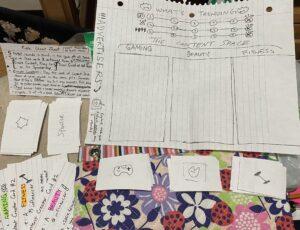
(An early paper prototype of our game)
Playtest #1
Importance of theme coherence: The first playtesting was done using a very basic prototype of our concept. Some of the mechanics unexpectedly added to the fun element. For example, people really liked the idea of having ‘beefs’ between the creators.
Balancing between systems game and party game elements: There were some questions that immediately came to our mind as we playtested the game. For instance, initially we viewed content creation as one of the core mechanics of our gameplay, but the feedback we received was that it feels too much like a party game.
Playing the characters: The biggest takeaway from the first playtest was that it was incredibly funny when people were playing the characters during the beefs. Although it only had a very simple skeleton of the game it evolved to be, the coherence of the theme added to the immersive experience.
Playtest #2
Engagement: There were comments on something not clicking about the core mechanics. We made more interactive actions between the players as a result, collaboration being one of the key aspects.
Non-linearity of the scoring mechanics: We had different scoring mechanics at this point, including money, followers, etc. This really prompted us to come up with more intuitive and coherent scoring mechanics.
Playtest #3
For playtest 2, we had a more advanced system. We added the mechanics of event cards and trends using a D6. The playtest felt way more smooth than our previous attempt, but we also saw some confusions, especially on our documentation of rules.
Balancing: One of the problem that our then-game had was that it incentivised safe strategies, which took away from the fun of risky behaviours. We had to do a value calculation and adjust the expected payoffs accordingly.
Roles and Agency: The fact that you’re given the theme of your channel / content material theme helped them be in character from the get-go, but some found it a bit restricting in the sense that you do not get to choose what you post on your channel, but are inherently bound by the theme you were assigned to from the start. This was instrumental in our decision to remove the pre-assigned theme, enabling the players to more strategically explore the different themes of the online contents.
Final Deliverable
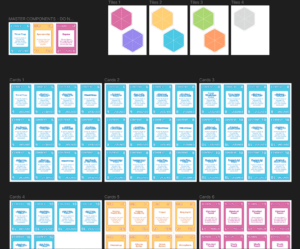 (Image from our Figma file)
(Image from our Figma file)
Clout Chasers can be played as a tabletop game. Our complete Figma file can be viewed with this link.
Here is the link to our final Rules Sheet and here is the CloutChasers Print & Play.
Enjoy!


